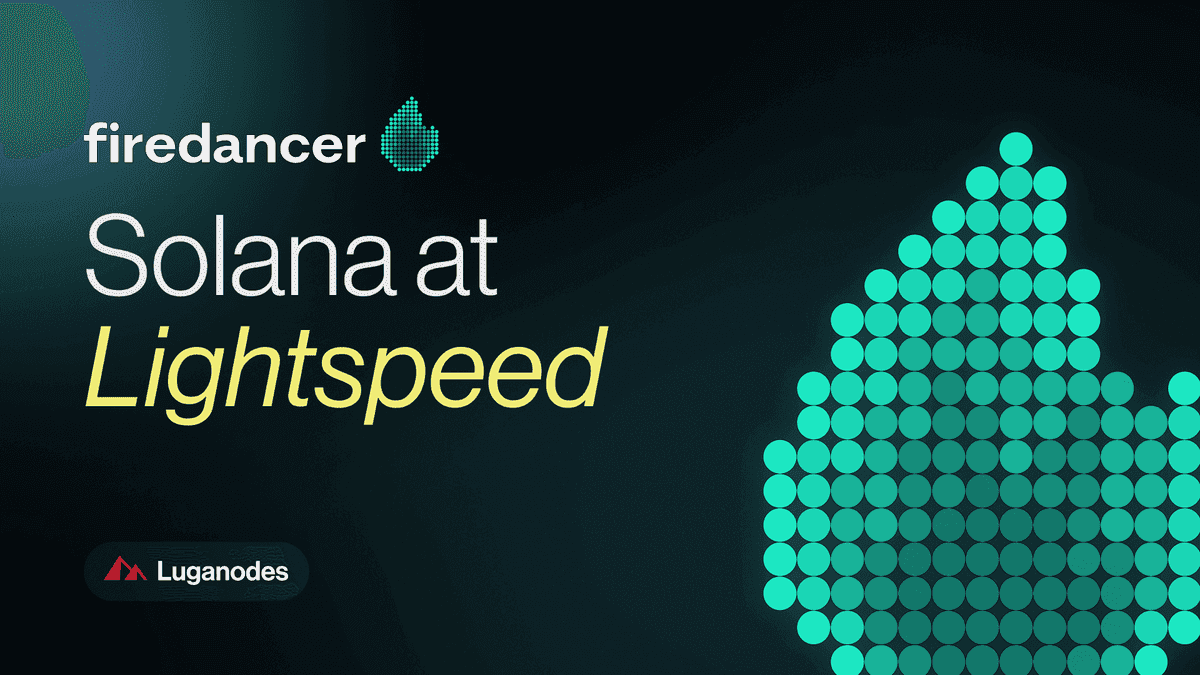4 min read
Firedancer: Solana at Lightspeed
A new client has appeared!

Introduction
We keep pushing the frontiers of Web3 technology, and progress is in leaps and bounds at Solana. Engineers and traders at Jump Crypto are building a new validator client for Solana from scratch, in C/C++.
It’s called Firedancer, and it’s already rewriting the limits of how fast, stable, and decentralized Solana can be.
Let’s break down what’s happening with Firedancer.
What’s a Validator Client?
Every blockchain runs validator software that processes transactions, builds blocks, and maintains consensus.
Having multiple independent clients matters for the health and longevity of the network:
- Prevents a single codebase failure: A bug in one client won't halt the entire chain.
- Improves resilience: The network can adapt and continue operating even if one client faces issues.
- Increases decentralization: Less reliance on a single team's engineering choices.
Solana’s original client is called Agave, built by Solana Labs.
Current Client Landscape
Solana now has four active validator setups on mainnet: Agave, the original client; Paladin, a client built around protection against sandwiching; and FrankenDancer, the early hybrid version of Firedancer. The + Jito denotes that the validator is using Jito’s MEV-enhanced client stack, layered on top of another Solana client.
FrankenDancer's share
FrankenDancer now secures over 21% of mainnet stake, and is growing fast.
Firedancer’s Architecture
Firedancer is a ground-up rebuild designed for performance down to the nanosecond. The architecture includes deep-level tweaks that help the validator handle a massive increase in activity.
Firedancer Features
- Designed for line-rate performance, over 1M TPS in test environments.
- Aims to increase Solana’s throughput from ~50,000 TPS to 0.6M–1.2M TPS.
- Achieves performance via splitting work across multiple CPU tiles / validators — Receive Side Scaling (RSS).
Real-World Performance: FrankenDancer
The hybrid “FrankenDancer” clients are already live on mainnet and proving themselves under stress. This version layers the new, highly-optimized Firedancer transaction processing unit (TPU) on top of the existing Agave client.
Performance reports show this hybrid client didn't drop a single transaction during periods of extreme load, like the highly congested Trump token launch.
They’re "really fast" and produce "really good blocks" even under extreme load, capturing more fees through smarter scheduling — meaning more revenue for the network and a more stable experience for users.
Smarter, Not Just Faster
Firedancer’s new scheduler optimizes how blocks are packed. A scheduler decides which task to run next, for how long, and in what order. In Firedancer, this is tuned to prioritize efficiency and value.
The goal: not maximum speed, but maximum efficiency in Solana’s compute-bound world.
The Goldilocks Rules of block packing:
- Don’t pack too fast: wait for better, more lucrative transactions.
- Don’t pack too slow: avoid creating empty space.
- Avoid over-parallelization: don't skip high-value transactions for speed.
“We may not be able to pack bigger blocks right now, but we’ll certainly pack better ones.”
Engineering Philosophy
Jump Crypto’s Firedancer team treats Solana like financial infrastructure, built to the laws of physics and information theory.
“Our role is to push the protocol to the limits of the laws of physics and information theory to make it viable for real-world applications.”
- Solana optimistic confirmation: 400–600 ms
- Deterministic finality today: ~12.8 seconds
- With Alpenglow upgrade: 100–150 ms deterministic finality
This brings Solana's latency into the range of centralized exchanges (19–500 ms) — combined with Firedancer's performance, the system moves into true financial-grade real-time computing territory.
The validator also includes visualization tools for every transaction, fee, and compute unit — full transparency for debugging and optimization.
Open Data and Community Programs
Users can track Firedancer’s performance at reports.firedancer.io — live metrics like avg. CUs, fees, total income, and vote success.
Operators can also join delegation.firedancer.io, where Jump matches stake with validators running FrankenDancer or Firedancer clients — incentivizing adoption and boosting client diversity.
The Big Picture
Firedancer goes beyond being a faster Solana client — it’s the foundation of:
- Client diversity
- Enterprise-grade reliability
- Protocol longevity
The introduction of Firedancer is expected to unlock Web2-scale applications running fully on-chain, while preserving Solana’s composability and speed.
About Luganodes
Luganodes is a world-class, Swiss-operated, non-custodial blockchain infrastructure provider that has rapidly gained recognition in the industry for offering institutional-grade services. It was born out of the Lugano Plan B Program, an initiative driven by Tether and the City of Lugano. Luganodes maintains an exceptional 99.9% uptime with round-the-clock monitoring by SRE experts. With support for 45+ PoS networks, it ranks among the top validators on Polygon, Polkadot, Sui, and Tron. Luganodes prioritizes security and compliance, holding the distinction of being one of the first staking providers to adhere to all SOC 2 Type II, GDPR, and ISO 27001 standards as well as offering Chainproof insurance to institutional clients.
The information herein is for general informational purposes only and does not constitute legal, business, tax, professional, financial, or investment advice. No warranties are made regarding its accuracy, correctness, completeness, or reliability. Luganodes and its affiliates disclaim all liability for any losses or damages arising from reliance on this information. Luganodes is not obligated to update or amend any content. Use of this at your own risk. For any advice, please consult a qualified professional.